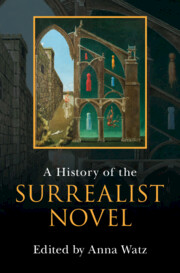Book contents
- A History of the Surrealist Novel
- A History of the Surrealist Novel
- Copyright page
- Dedication
- Contents
- Figures
- Contributors
- Acknowledgements
- Introduction
- I Marvellous Beginnings
- II Transgression and Excess
- Chapter 7 The Surrealist Novel and the Gothic
- Chapter 8 Surrealism’s Anti-Bildungsroman
- Chapter 9 The Mother Figure in the Surrealist Novel
- Chapter 10 British Surrealism at War
- Chapter 11 Surrealist Narratives of Trauma
- III Science, Alchemy, Nature
- IV Transnational Surrealism
- Index
Chapter 11 - Surrealist Narratives of Trauma
from II - Transgression and Excess
Published online by Cambridge University Press: 02 February 2023
- A History of the Surrealist Novel
- A History of the Surrealist Novel
- Copyright page
- Dedication
- Contents
- Figures
- Contributors
- Acknowledgements
- Introduction
- I Marvellous Beginnings
- II Transgression and Excess
- Chapter 7 The Surrealist Novel and the Gothic
- Chapter 8 Surrealism’s Anti-Bildungsroman
- Chapter 9 The Mother Figure in the Surrealist Novel
- Chapter 10 British Surrealism at War
- Chapter 11 Surrealist Narratives of Trauma
- III Science, Alchemy, Nature
- IV Transnational Surrealism
- Index
Summary
Unica Zürn’s narratives exemplify the post-1945 afterlife of surrealist narrative forms, which persist as mutations ruptured by historical trauma, marked by and constitutive of the fractured, damaged temporalities of subjective and historical experience. Joao Ribas has commented on how Zürn’s drawings exploit a ’repertoire of surrealist techniques’ (Dark Spring, 21); her writings similarly adapt many familiar surrealist narrative-aesthetic traits and practices to explore specific German post-war and post-Shoah contexts, deploying strategies of automatism, prolepsis, cryptographic and other phantasmagorical techniques, fairytale, literary, cinematic and other allusions, alongside formally experimental, densely polysemic, and allegorically autobiographical structures. Adapting the extensive archival resources provided by surrealist techniques enabled Zürn to produce narratives focused on representing and navigating the damaged durational temporalities of traumatic experience, encountered as simultaneously subjective (and thus rooted in problematically autobiographical narratives) and social (and thus grounded in shattering historical events and their disastrous psychological impacts). The essay examines key works to explore her insistent linguistic registering of trauma through a poetics of the fragment – a remnant of shattered language, and a preoccupation she inherited from her involvement with Alexander Camaro and the post-war Berlin surrealist group Der Badewanne and its aesthetics of constrained recycling as a response to the post-war scarcity of art materials – in which meaning is encrypted, demanding decoding by the reader.
- Type
- Chapter
- Information
- A History of the Surrealist Novel , pp. 184 - 202Publisher: Cambridge University PressPrint publication year: 2023



